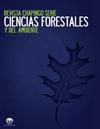柚木人工林调查的角度抽样法
IF 0.5
4区 农林科学
Q3 Agricultural and Biological Sciences
Revista Chapingo Serie Ciencias Forestales Y Del Ambiente
Pub Date : 2020-08-30
DOI:10.5154/r.rchscfa.2019.11.081
引用次数: 1
摘要
引言:尽管需要相当长的时间,但在森林清查中,按固定面积地块取样是通常的做法。另一种采样方法是角度计数法或Bitterlich法。目的:评价角度抽样法测定柚木人工林计量变量的准确性和有效性。材料和方法:在一个为期三年的柚木种植园中,建立了21个500平方米的圆形地块。在每个地块中,确定了乳房水平的直径、每棵树的高度和位置、工作时间、每公顷树木的数量、平均基底面积的直径、总基底面积、平均Lorey水平和总体积。使用0.5、1、1.5和2的基底面积因子(BAF)模拟角度采样。使用ANOVA比较每个BAF和固定面积图的变量估计值,并确定相对效率。结果和讨论:方差分析没有检测到显著差异(P结论:角度计数准确且更有效地估计幼龄柚木种植园的计量变量。本文章由计算机程序翻译,如有差异,请以英文原文为准。
Angle sampling method for the inventory of teak plantations (Tectona grandis L. f.)
Introduction: Sampling by fixed area plots is the usual practice in forest inventories, despite the considerable time involved. An alternative method of sampling is the angle count or Bitterlich method.
Objective: To evaluate the accuracy and efficiency of the angle sampling method for the determination of dasometric variables in teak (Tectona grandis L. f.) plantations.
Materials and methods: In a three-year teak plantation, 21 circular plots of 500 m2 were established. In each plot, the diameter at breast level, the height and position of each tree, the working times, the number of trees per hectare, the diameter of the average basal area, the total basal area, the average Lorey level and the total volume were determined. Angular sampling was simulated using basal area factors (BAF) of 0.5, 1, 1.5 and 2. The estimates of the variables for each BAF and fixed area plots were compared using ANOVA and the relative efficiency was determined.
Results and discussion: The ANOVA did not detect significant differences (P
Conclusions: Angular counting is accurate and more efficient for estimating dasometric variables in young teak plantations.
求助全文
通过发布文献求助,成功后即可免费获取论文全文。
去求助
来源期刊
CiteScore
1.20
自引率
16.70%
发文量
0
审稿时长
>12 weeks
期刊介绍:
The Revista Chapingo Serie Ciencias Forestales y del Ambiente (RCHSCFA) is a scientific journal that aims to raise awareness of high-quality research products related to forest, arid, temperate and tropical environments in the world. Since its foundation in 1994, the RCHSCFA has served as a space for scientific dissemination and discussion at a national and international level among academics, researchers, undergraduate and graduate students, forest managers and public/private entities that are interested in the forest environment.
All content published in the journal first goes through a strict triple-blind review process and is published in the following formats: Scientific Articles, Review Articles, Methodologies, Technical or Technological Notes.

 求助内容:
求助内容: 应助结果提醒方式:
应助结果提醒方式:


